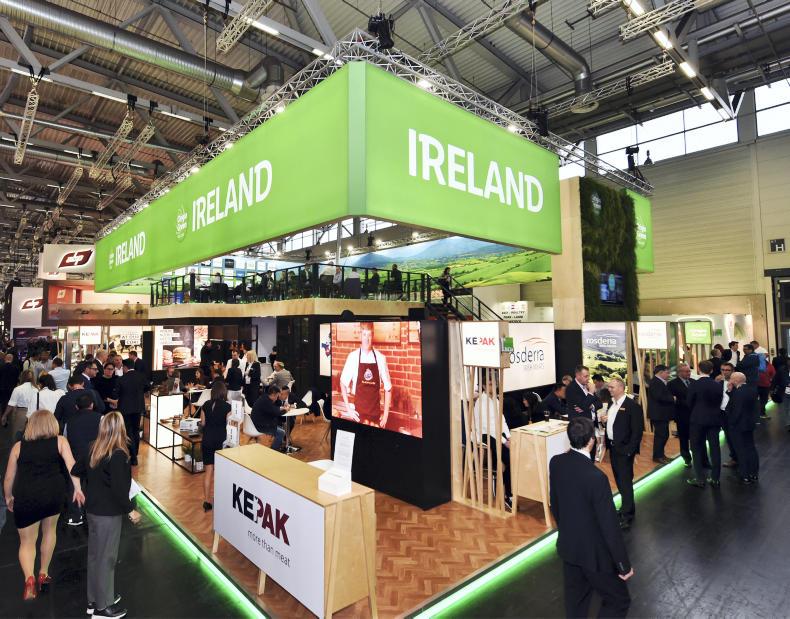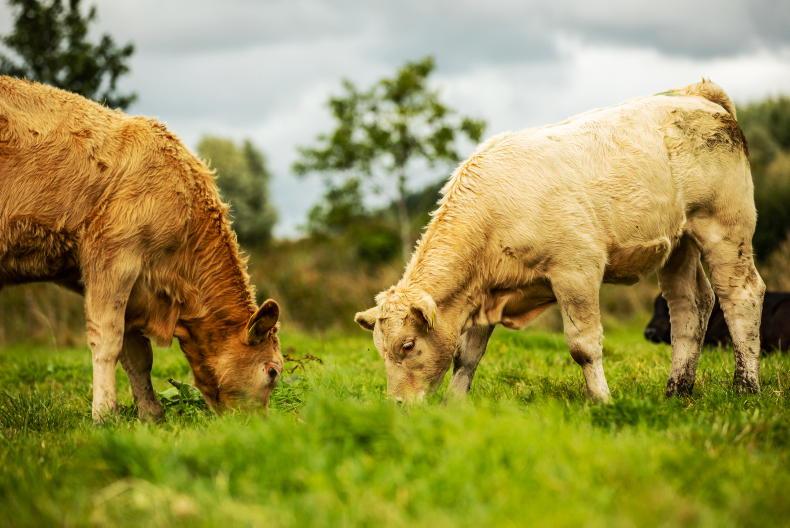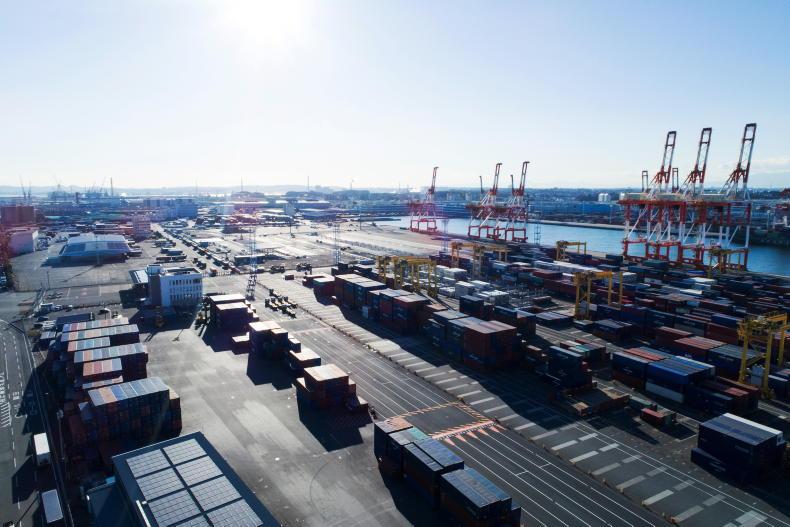Beef and sheepmeat production are the largest farming sectors in Ireland along with dairy but in 2019, it was the two intensive sectors of pigmeat and poultry that were top performers.
Both these sectors have just a few hundred farmers involved yet they produce sufficient raw material to sustain thousands of jobs in the processing sector.
Bord Bia followed up the launch of its performance and prospects report last week with in-depth analysis at its meat outlook conference on Friday.
Justin Sherrard from Rabobank gave the keynote address on “Global animal protein in the 2020s – Finding opportunities in a changing world.”
Rabobank, originally a Dutch bank but now a multinational institution that focuses particularly on agriculture, is a recognised global leader in studies on agriculture and market forecasts for agricultural commodities.
Unsurprisingly, Sherrard identified African swine fever in Asia, particularly China, as a global game changer for animal proteins in at least the first half of this decade. Sustainability will increasingly shape production and consumption in the next 10 years, with growth in competition from non-animal proteins or meat alternatives.
However, he was of the view that while the alternatives will continue to grow, they tend to have less protein and more fat than meat itself.
Beef and live cattle exports
Cattle supplies fell by 3% or 60,500 head to 1.74 million. The reduction came from a fall in kill numbers for steers (-41,000) and cows (-48,000) although other categories have increased: young bulls (+5,500) and heifers (+17,000).
Improved grazing conditions in 2019 saw carcase weights increase by 6.8kg on average, offsetting the reduced cattle numbers, leading to a 1.5% reduction in beef production to 624,000t. Overall, the value of Irish beef exports (excluding offal) declined by 7% in value in 2018 to a value of €2.25bn from €2.45bn in 2018.
Sustainability will increasingly shape production and consumption in the next 10 years, with growth in competition from non-animal proteins or meat alternatives
Live exports increased by 20%, the highest since 2010, at 300,000 head. Again this year, calf exports dominate the live trade with numbers up 24% to reach 200,000, driven by a 73% increase in exports to the Netherlands. However, adult cattle exports increased by 22% to 29,000 head and weanlings and stores recorded modest growth of 3% to reach 66,000 head.
Exports to Turkey fell by 20% to 10,239 following the suspension of import licences due to over-supply in the Turkish market. After two years of decline, exports to Northern Ireland rose by 37% to 32,616 while sales to the UK remained static at 5,397 head.
Total beef consumption across the EU fell by 0.9% reflecting a shift in dietary choices. For Irish beef exporters this reduction in demand was most keenly felt in the UK markets which saw an 11% decline in the volume of Irish beef exports, to 265,000 tonnes. The UK now accounts for 47% of Irish beef exports compared to 52% in 2018, valued at €990 million.
Exports to Continental markets remained static at 250,000t. However, France recorded 4% growth and Germany 3%. International markets recorded significant growth, rising to 45,000t – an 80% increase on last year. International markets now account for 8% of Irish beef exports, led by the Philippines at 18,000t (valued at €34m). After the first full year of trading, beef exports to China reached €31m or 12,000t. Though it is still a small market for Irish beef exports, there was also a doubling of sales to the USA from 2,500t to over 5,000t in 2019.
During 2019, Irish R3 steer prices declined by 6.8% on 2018 to an average of €3.60/kg, down from €3.85/kg in 2018. Prices for Irish R3 steers were on par with Continental EU prices when comparing averages across the 15 Continental market but behind on UK prices at €3.88/kg.
The UK now accounts for 47% of Irish beef exports compared to 52% in 2018, valued at €990 million
Numbers on the ground
In 2019, registered births from suckler cows fell by 27,000 head while dairy calf registration rose by 23,000.
AIM’s data indicate that there were 14,000 more male cattle and 2,000 more heifers between 24 and 26 months still in the system as of November, when compared to 2018. Numbers of cattle between 12 and 24 months are 55,000 back on November last year (-19,000 heifers and -36,000 male).
Numbers of young male cattle under 12 months are down 45,000, while the number of females are under by 7,000.
In the UK, our key export market consumption fell by 2.1%. Consumption in France (the second-largest market for Irish beef) fell by 3.1% while Sweden recorded the largest decline in consumption at 3.5%.
Positively, beef consumption rose in both the Netherlands (1.3%) and Italy (0.2%), while German beef consumption is unchanged. EU beef production declined by 0.5% in 2019 and a further decline of 0.5% is forecast for 2020.
Reflecting EU-wide trends, Irish pig supplies (including live exports) fell 1.5% during 2019 to 3.4 million head. Total EU pigmeat production fell by 1%, with production in Denmark falling by 6.8% and Poland by 4.6%. Production in Germany – the largest pigmeat producer in the EU – fell by 2.2%.
Following a disappointing year in 2018 (and the latter part of 2017), prices recovered strongly from the second quarter last year. The increase in prices can be attributed to the dramatic demand created in Asia as African swine fever (ASF) decimates local production.
Average pig prices were 18% higher in 2019 versus 2018 at €1.64/kg excluding VAT. By the end of 2019, Irish prices were making record prices at €1.90/kg excluding VAT. The strong prices led to a 14% rise in the value of pigmeat exports to reach close to €1bn for the first time (€941m).
Total EU pigmeat production fell by 1%, with production in Denmark falling by 6.8% and Poland by 4.6%. Production in Germany – the largest pigmeat producer in the EU – fell by 2.2%
In 2019, EU pigmeat exports rose by 18% higher to 3.9m tonnes, with exports to China rising by 63% in the first 10 months of the year. Irish pigmeat exports to China are expected to reach a record of 82,000t for the year. Global pigmeat trade is predicted by Rabobank to exceed 8m tonnes in 2020, more than double the 4m tonnes traded in 2015.
A further decline in Chinese pigmeat production is forecast in 2020, with the herd expect to fall under 200m head from pre-ASF levels of 600m head. Rebuilding is expected in the second half of 2020 but the structure of pigmeat production will be completely changed, with backyard production (of 50 pigs or less), which once accounted for 71% of Chinese production, set to account for just 1% by 2025. It is expected that 47% of production will come from holdings of 10,000 pigs or more by 2025.
With other Asian countries also struggling to contain ASF, this is expected to have a significant impact on global production for 2020, with latest projections from GIRA indicating that output could fall by 13% to 85m tonnes.
Irish poultry production hit record numbers of 106m birds in 2019, with exports increasing by 5% in value to €306m. Poultry imports to Ireland fell by 3%, while the EU overall saw an 11% increase in imports from outside the EU.
EU chicken output increased by 2% to 12.5m tonnes, while globally poultry production continues to grow with production at 99.5m tonnes in 2019.
Global chicken output has grown by 13% since 2015 and is predicted to reach over 103m tonnes in 2020. Both Brazil and Thailand are expected to see record production in 2020. China will absorb more than half of this increase, as ASF impacts Chinese consumers’ protein choices.
It was a challenging year for the Irish sheep sector with strong UK lamb supplies (6.89m head through UK factories) and a 2% reduction in consumption across the EU suppressing prices. Carcase weights reached a 10-year high of 21.19kg, up 0.7kg on 2018, and average weights for spring lambs were 20.62kg, up 1% on last year. However, throughput was down 7% on last year, leaving overall sheepmeat production down 3% on last year to 67,415t. Spring lamb disposals were just 1% back on 2018, while hogget numbers were down 11% to 739,027.
Globally poultry production continues to grow with production at 99.5m tonnes in 2019
Farmers in New Zealand achieved record prices of +NZ$9/kg driven by strong demand from China, a market which accounts for 57% of New Zealand’s exports. The US is the highest-paying for New Zealand lamb ($17.79/kg), with demand driven by premium retailers, foodservice (restaurants, etc) and ethnic consumers.
US sheepmeat imports have grown rapidly in five years, with volumes up 46% on 2013. Australia still commands a 78% market share, followed by 20% from New Zealand.
Thirteen per cent of Australia’s national flock live in regions which have been significantly impacted by the bushfires which continue to rage. The national flock has declined by 6.5% due to continued drought.
Chinese sheepmeat imports reached a record high of 379,000t in 2019, with last October’s prices up 25.8% on 2018. In the Middle East, strong oil prices and reduced supplies of live exports from Australia have driven EU live trade. EU shipments to Iran commenced in 2019 reaching 139,000 head. 2019 witnessed high demand in North Africa for live sheep, with numbers reaching one million.
Despite being another successful year for Irish exports from the meat sector, it was a disaster for beef producers and sheep farmers too had to endure much lower average prices (25c/kg) than the previous year. The difficulty in the beef sector was recognised with the joint EU-Government Brexit compensation scheme which applied to cattle processed in late 2018 but finishing in May.
Even in good years, beef production is a marginal business for farmers, yet its value to the wider economy is clearly demonstrated in the export and employment figures. This demonstrated the need for a properly funded CAP as a minimum with ideally additional support mechanisms to sustain farmers in primary production.
What Irish farmers do in producing raw material is of huge value to the Irish economy and it is essential that this is recognised by maximising the market value and a support structure that makes farming viable.
Beef and sheepmeat production are the largest farming sectors in Ireland along with dairy but in 2019, it was the two intensive sectors of pigmeat and poultry that were top performers.
Both these sectors have just a few hundred farmers involved yet they produce sufficient raw material to sustain thousands of jobs in the processing sector.
Bord Bia followed up the launch of its performance and prospects report last week with in-depth analysis at its meat outlook conference on Friday.
Justin Sherrard from Rabobank gave the keynote address on “Global animal protein in the 2020s – Finding opportunities in a changing world.”
Rabobank, originally a Dutch bank but now a multinational institution that focuses particularly on agriculture, is a recognised global leader in studies on agriculture and market forecasts for agricultural commodities.
Unsurprisingly, Sherrard identified African swine fever in Asia, particularly China, as a global game changer for animal proteins in at least the first half of this decade. Sustainability will increasingly shape production and consumption in the next 10 years, with growth in competition from non-animal proteins or meat alternatives.
However, he was of the view that while the alternatives will continue to grow, they tend to have less protein and more fat than meat itself.
Beef and live cattle exports
Cattle supplies fell by 3% or 60,500 head to 1.74 million. The reduction came from a fall in kill numbers for steers (-41,000) and cows (-48,000) although other categories have increased: young bulls (+5,500) and heifers (+17,000).
Improved grazing conditions in 2019 saw carcase weights increase by 6.8kg on average, offsetting the reduced cattle numbers, leading to a 1.5% reduction in beef production to 624,000t. Overall, the value of Irish beef exports (excluding offal) declined by 7% in value in 2018 to a value of €2.25bn from €2.45bn in 2018.
Sustainability will increasingly shape production and consumption in the next 10 years, with growth in competition from non-animal proteins or meat alternatives
Live exports increased by 20%, the highest since 2010, at 300,000 head. Again this year, calf exports dominate the live trade with numbers up 24% to reach 200,000, driven by a 73% increase in exports to the Netherlands. However, adult cattle exports increased by 22% to 29,000 head and weanlings and stores recorded modest growth of 3% to reach 66,000 head.
Exports to Turkey fell by 20% to 10,239 following the suspension of import licences due to over-supply in the Turkish market. After two years of decline, exports to Northern Ireland rose by 37% to 32,616 while sales to the UK remained static at 5,397 head.
Total beef consumption across the EU fell by 0.9% reflecting a shift in dietary choices. For Irish beef exporters this reduction in demand was most keenly felt in the UK markets which saw an 11% decline in the volume of Irish beef exports, to 265,000 tonnes. The UK now accounts for 47% of Irish beef exports compared to 52% in 2018, valued at €990 million.
Exports to Continental markets remained static at 250,000t. However, France recorded 4% growth and Germany 3%. International markets recorded significant growth, rising to 45,000t – an 80% increase on last year. International markets now account for 8% of Irish beef exports, led by the Philippines at 18,000t (valued at €34m). After the first full year of trading, beef exports to China reached €31m or 12,000t. Though it is still a small market for Irish beef exports, there was also a doubling of sales to the USA from 2,500t to over 5,000t in 2019.
During 2019, Irish R3 steer prices declined by 6.8% on 2018 to an average of €3.60/kg, down from €3.85/kg in 2018. Prices for Irish R3 steers were on par with Continental EU prices when comparing averages across the 15 Continental market but behind on UK prices at €3.88/kg.
The UK now accounts for 47% of Irish beef exports compared to 52% in 2018, valued at €990 million
Numbers on the ground
In 2019, registered births from suckler cows fell by 27,000 head while dairy calf registration rose by 23,000.
AIM’s data indicate that there were 14,000 more male cattle and 2,000 more heifers between 24 and 26 months still in the system as of November, when compared to 2018. Numbers of cattle between 12 and 24 months are 55,000 back on November last year (-19,000 heifers and -36,000 male).
Numbers of young male cattle under 12 months are down 45,000, while the number of females are under by 7,000.
In the UK, our key export market consumption fell by 2.1%. Consumption in France (the second-largest market for Irish beef) fell by 3.1% while Sweden recorded the largest decline in consumption at 3.5%.
Positively, beef consumption rose in both the Netherlands (1.3%) and Italy (0.2%), while German beef consumption is unchanged. EU beef production declined by 0.5% in 2019 and a further decline of 0.5% is forecast for 2020.
Reflecting EU-wide trends, Irish pig supplies (including live exports) fell 1.5% during 2019 to 3.4 million head. Total EU pigmeat production fell by 1%, with production in Denmark falling by 6.8% and Poland by 4.6%. Production in Germany – the largest pigmeat producer in the EU – fell by 2.2%.
Following a disappointing year in 2018 (and the latter part of 2017), prices recovered strongly from the second quarter last year. The increase in prices can be attributed to the dramatic demand created in Asia as African swine fever (ASF) decimates local production.
Average pig prices were 18% higher in 2019 versus 2018 at €1.64/kg excluding VAT. By the end of 2019, Irish prices were making record prices at €1.90/kg excluding VAT. The strong prices led to a 14% rise in the value of pigmeat exports to reach close to €1bn for the first time (€941m).
Total EU pigmeat production fell by 1%, with production in Denmark falling by 6.8% and Poland by 4.6%. Production in Germany – the largest pigmeat producer in the EU – fell by 2.2%
In 2019, EU pigmeat exports rose by 18% higher to 3.9m tonnes, with exports to China rising by 63% in the first 10 months of the year. Irish pigmeat exports to China are expected to reach a record of 82,000t for the year. Global pigmeat trade is predicted by Rabobank to exceed 8m tonnes in 2020, more than double the 4m tonnes traded in 2015.
A further decline in Chinese pigmeat production is forecast in 2020, with the herd expect to fall under 200m head from pre-ASF levels of 600m head. Rebuilding is expected in the second half of 2020 but the structure of pigmeat production will be completely changed, with backyard production (of 50 pigs or less), which once accounted for 71% of Chinese production, set to account for just 1% by 2025. It is expected that 47% of production will come from holdings of 10,000 pigs or more by 2025.
With other Asian countries also struggling to contain ASF, this is expected to have a significant impact on global production for 2020, with latest projections from GIRA indicating that output could fall by 13% to 85m tonnes.
Irish poultry production hit record numbers of 106m birds in 2019, with exports increasing by 5% in value to €306m. Poultry imports to Ireland fell by 3%, while the EU overall saw an 11% increase in imports from outside the EU.
EU chicken output increased by 2% to 12.5m tonnes, while globally poultry production continues to grow with production at 99.5m tonnes in 2019.
Global chicken output has grown by 13% since 2015 and is predicted to reach over 103m tonnes in 2020. Both Brazil and Thailand are expected to see record production in 2020. China will absorb more than half of this increase, as ASF impacts Chinese consumers’ protein choices.
It was a challenging year for the Irish sheep sector with strong UK lamb supplies (6.89m head through UK factories) and a 2% reduction in consumption across the EU suppressing prices. Carcase weights reached a 10-year high of 21.19kg, up 0.7kg on 2018, and average weights for spring lambs were 20.62kg, up 1% on last year. However, throughput was down 7% on last year, leaving overall sheepmeat production down 3% on last year to 67,415t. Spring lamb disposals were just 1% back on 2018, while hogget numbers were down 11% to 739,027.
Globally poultry production continues to grow with production at 99.5m tonnes in 2019
Farmers in New Zealand achieved record prices of +NZ$9/kg driven by strong demand from China, a market which accounts for 57% of New Zealand’s exports. The US is the highest-paying for New Zealand lamb ($17.79/kg), with demand driven by premium retailers, foodservice (restaurants, etc) and ethnic consumers.
US sheepmeat imports have grown rapidly in five years, with volumes up 46% on 2013. Australia still commands a 78% market share, followed by 20% from New Zealand.
Thirteen per cent of Australia’s national flock live in regions which have been significantly impacted by the bushfires which continue to rage. The national flock has declined by 6.5% due to continued drought.
Chinese sheepmeat imports reached a record high of 379,000t in 2019, with last October’s prices up 25.8% on 2018. In the Middle East, strong oil prices and reduced supplies of live exports from Australia have driven EU live trade. EU shipments to Iran commenced in 2019 reaching 139,000 head. 2019 witnessed high demand in North Africa for live sheep, with numbers reaching one million.
Despite being another successful year for Irish exports from the meat sector, it was a disaster for beef producers and sheep farmers too had to endure much lower average prices (25c/kg) than the previous year. The difficulty in the beef sector was recognised with the joint EU-Government Brexit compensation scheme which applied to cattle processed in late 2018 but finishing in May.
Even in good years, beef production is a marginal business for farmers, yet its value to the wider economy is clearly demonstrated in the export and employment figures. This demonstrated the need for a properly funded CAP as a minimum with ideally additional support mechanisms to sustain farmers in primary production.
What Irish farmers do in producing raw material is of huge value to the Irish economy and it is essential that this is recognised by maximising the market value and a support structure that makes farming viable.










SHARING OPTIONS